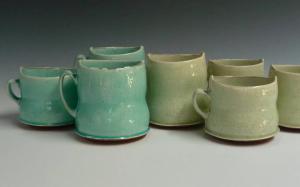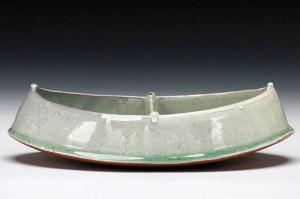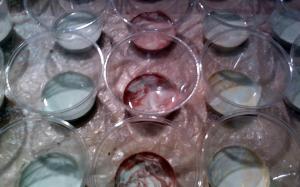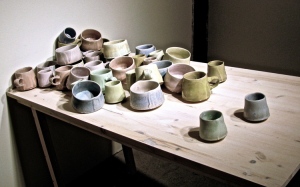Just in time for Valentine’s Day…an interview with the lovely and fabulous Birdie Boone! I first met Birdie in 2007 at the Archie Bray Foundation in Helena, MT, where her and I were fellow resident artists. I’ve always admired Birdie’s work for its subtlety, depth and design. She is a master of glaze calculation…constantly experimenting with color palette and surface quality. Birdie’s work fits seamlessly into the rhythms of everyday life…the thoughtfulness of her processes evident in each finished piece.
Looking to find more of Birdie’s work or perhaps wanting to add a piece of hers to your kitchen? Here’s where:
Birdie has a solo exhibition at the Schaller Gallery (Feb 1 to Feb 19). Dozens of beauties ready and available for a new home.
Birdie’s work will be on display at Studio KotoKoto’s (www.studiokotokoto.com) Valentine’s Day event starting Tuesday, Feb 5th at 9am PST. Kotokoto is also featuring a giveaway contest for a pair of Birdie’s cups: 5-7-5: A Valentine’s Day Haiku Contest. Here’s the link: http://www.studiokotokoto.com/5-7-5-a-valentines-day-haiku-contest/ Entries must be made by Feb. 12th.
I hope you enjoy the interview as much as I did!
How did you first get involved in ceramics?
My earliest experience with ceramics involved an appreciation of pots hand made by my best friend’s mom; I noticed them in a way that stood out from everything else around me. While I was still very young, I took clay classes in San Francisco, but I was in college by the time I realized how much it meant to me. Freshman year, I took the prerequisites I needed to get into a ceramics course and by my sophomore year, I had chosen to major in art.
Can you briefly describe your background and education?
I was raised in both San Francisco, California and in Abingdon, in southwestern Virginia. I attended the College of William and Mary in Virginia and graduated in 1993 with a BA in Art/Art History. From 1999 to 2002, I taught ceramics and sculpture as adjunct faculty at Emory and Henry College, a small Virginia college. Then, in the fall of 2002 I entered the graduate program in ceramics at the University of Massachusetts, Dartmouth. I received an MFA in Artisanry/Ceramics in 2005. Following that, I worked at the Worcester Center for Crafts in Worcester, MA for two years, then headed out to Montana for a long term residency at the Archie Bray Foundation. In 2010, I returned to teach at Emory and Henry College in Virginia for a year. In 2011, I moved to Santa Fe, New Mexico, where I currently live and make pots.
How do you feel that your formal education (undergraduate-graduate school) prepared you for your career in ceramics? Is there anything you wish you had known before leaving school?
To be honest, when I left college, I didn’t expect to have a career in ceramics specifically. I went to a liberal arts school and word on the street was, “do art now because you may never have another opportunity!” I did love it though, so I worked hard to find ways to keep making. Early on, I thought I’d just hop on into grad school; I was not admitted and, true to character, swore grad programs to the depths of hell. Several years later, I realized I still wanted to have a career in ceramics, so I started looking at doing graduate work…again. My program (Umass Dartmouth) was really well-rounded, I have to say. I came away with a strong background in all aspects of ceramics, a very strong sense of personal accomplishment and also a sense of momentousness about the role of artists in our society. Although at the time I expected to find myself teaching rather than being a studio potter, I do wish I had heard more ‘real stories’ about working artists, especially in terms of whether the numbers can add up when pots are the only means of income (I later learned that this is rarely the case).
How would you describe your work? How did you arrive at working this way?
My forms are soft, minimal, hand built pots made from slabs of clay. I always let seams and points of attachment remain visible as much as possible. Each pot has a layer of bisque/crackle slip under it’s glaze to help create visual depth. The glaze may be transparent or semi-transparent and often has a small amount of colorant, lending the glaze a pale/pastel softness of color. My pots tend to be intimate in size, encouraging a familiar engagement of the senses. The evolution of my work is a case of form following concept: ‘domestic intimacy’ is a term I coined to identify the importance of nourishment, both physical and emotional; the presence in our lives of soft, inviting objects that command a sensual recognition is what compels my formal/aesthetic decisions.
Would you explain your attraction to functional ceramics?
Ceramic objects that can be useful in our everyday lives have a way of affecting our natures. If my agenda as an artist is to call attention to important things, then what better way to deliver on this than by means of practical necessity? Our brains don’t have to work to figure out ‘what it means’. Meaning is absorbed through a pot’s characteristics as it is being used; even when it is not being used, it can affect its environment in a nurturing way.
What is the inspiration for your pieces? How do you come up with new ideas? Can you walk us through your creative process when coming up with new forms/ideas?
My work debuted with inspiration from my family and the experiences I had as a child, specifically regarding eating habits. As my work evolves, I continue to look to eating habits, but they are the experiences and insights of an adult in the present (and sometimes the future). In this, there are always new ideas. In addition, I look to the past, to domestic objects made from clay, metal, wood and fiber, both industrial and handcrafted. If I see something I like, I figure out what fundamental qualities draw my attention and then adapt them to my own certain representation. Over the years, I have developed a couple of structural formats: ‘Curvy’ and ‘Belly Bottomed’. In general, when I want to incorporate a new form, I will try to work it into one of these styles. If it’s successful, great, if it’s not, then the public never sees it! I have a paper pattern for each form I make and often a new form can be created by modifying one of my existing patterns. I cut a paper pattern that I think will get me close to the form I’m after, then cut out the clay pieces and alter them as needed as I assemble. Then I go back to the paper pattern and snip and shape. I do this until I get what I want. Recently, I have expanded the variety of forms I make by taking one form and then reproducing it in assorted sizes and shapes. For example, if I make a round bowl, I will make it in 3 to 6 different sizes and then I will make it ovoid and rectangular, also in assorted sizes. This really speaks to my inclination to work in multiples without making the same thing over and over again.
Having shared a studio wall with you at the Archie Bray Foundation, I know that you are fascinated with glaze chemistry. I always admired the countless test tiles I’d see piling up in your studio space. Can you talk a little about the importance of glaze/surface when it comes to your work?
The surface of a pot is just as important as the pot itself. Either can undermine the other if
consideration isn’t given to both. My love for glazes comes from the idea that a glaze surface has a few variables that can be manipulated toward a concept: light transmission, color, and tactile quality can all be chosen with intent. I appreciate the infinite possibilities that present themselves through glaze development.
Like Jeff Campana (last month’s featured potter), I know you moved around a lot post graduate-school. How have these experiences after school prepared you for where you are now? Could you describe some of the most influential or career changing experiences you’ve had since you’ve left school?
I think that working hard, holding a job alongside a studio commitment has reinforced my passion for making. Through all the frustrations of too little time, little or no money, and creative hinderance, I have learned what is really important to me. I don’t discount any experience, whether positive or negative, but I think the most powerful experience I had was my residency at the Archie Bray Foundation. It was a time when I not only fortified my commitment to making, but also a time for intuitive introspection (unlike graduate school, where introspection was paramount, but also forced). It was important to attain an awareness of my character because my work comes from such a personal place. The Bray afforded me the time and space to achieve that and I departed with a strong sense of direction.
Was there a point in your career that you made a decision to sell your pots for a living? Could you describe how you came to that decision?
That decision came just last summer, so it’s still green…it was a decision of circumstances because I was unemployed and not able to find work in the field. I wish I could say I was a goal, but the truth is that I’ve always been apprehensive about making a living from my pots. Nevertheless, I suddenly had the time and space to make work, so I did. I am still in the process of organizing a business model and think it’ll take the year, at least, to do it right. I hold great esteem for working potters like Ayumi Horie, Diana Fayt and Kristen Kieffer, but I have no misconceptions that I’m years away from that level of success.
How have your experiences so far been different or similar to your expectations when you set out?
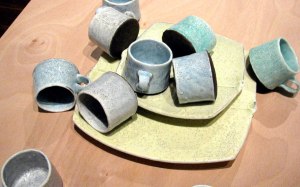
from Domestic Landscape Series: Lemon French Toast with Blueberries (plates and espresso cups), various sizes, cone 5 oxidation, 2012
I don’t know that I had expectations so much as aspirations: I always wanted to follow in my college professor’s footsteps, to pay forward the satisfaction from creativity that she had enabled in me. Events, however, have conspired to take me in a different direction. Of course, I expected to be famous by now, but I guess since people are living longer these days, stardom may be a little further down the road… ;P
What does a typical workday look like for you? How much do you spend on marketing vs. making?
Okay, cat outta the bag kind of thing: I don’t have a typical workday, unless it can be that I piddle around doing nothing much until a deadline looms. Seriously, someone should give me a bagful of time management skills! When I am on a roll in the studio, though, it’s hard to stop and when I do something like work on my website, it’s also hard to stop. As I mentioned, the business of making pots for a living is still green. In theory, though, I currently set aside one day a week to do paperwork, etc…
How does an artist go about acquiring business and marketing skills? What piece of advice would you give to others just starting out?
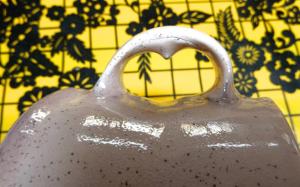
cup detail, Heart in Hand(le), cups for Studio Kotokoto’s Hearty Cuppa Event, cone 5 oxidation, 2013
Trick question (since I’m just starting out)! Trial and error is often the most informative way to figure out what works for you and what doesn’t. I have also found it helpful to talk to artists who are successfully selling their work, look at how they market and note what might be a good fit for me. This does not mean that I let them do all the hard work and then just appropriate from their models. I am grateful for their support in terms of finding a path to success since there aren’t too many courses out there on how to market pottery in today’s economy. To those just starting out, I would definitely mention that you shouldn’t expect immediate success. Like any business, you have to increase exposure and, to some extent, establish a customer base and that simply takes time. Also, unless you are debt free and securely sheltered, don’t expect to do this without some additional source of income.
What is your relationship with galleries (on and offline)? How has that relationship changed over time?
There are a handful of galleries that carry my work. I maintain a relationship with these galleries based on the premise that they work hard to promote my work and attract a clientele that can appreciate my subtle aesthetics. I have to say that it has been frustrating when I don’t even sell enough to cover the costs of packing materials and shipping. I continue to send work, though, because galleries have the resources to provide a level of exposure that I can’t reach on my own. There is definitely something to be said about putting your work in the hands of someone (gallerist) who believes in what you do.
One thing I find intriguing about your work is the way that you conceive and install your pots in a gallery setting (particularly with your solo exhibitions). As a fellow potter, my motivation to make work is based on the work eventually participating in a domestic environment. I particularly love the fact that pots in the home are never stagnant, but rather are constantly resonating with potential energy. The gallery space almost acts as an intermediary venue (between studio and home) that allows the viewer to focus on the “still” object free of domestic “noise” (which I find rather refreshing). Can you describe how do you approach the gallery space as a venue for display?
I also regard domestic environments as natural habitats for useful objects. My motivation to ‘install’ pots comes from an impulse to give viewers in a gallery setting a sense of the emotional substance that may present itself (in past, present and future possibilities) once the pots are in a real domestic environment by assembling them allegorically within a fabricated domestic representation or arrangement.
Finally, what advice can you give aspiring artists struggling to find their own voice/style?
It is my belief that solid work comes from within. You have to search internally for whatever meaning (voice) you want to ascribe to your work. You may be influenced by your environment, as we all are, but don’t let someone else’s agenda get in the way. Keep it about you. As a maker of pots, understand that bowls, cups, plates, etc…were invented long ago; you are not the engineer of these objects, but a steward of their legacy. A good pot is an honest pot, one that is true to it’s purpose (which may be both utilitarian and aesthetic), no more, no less.
To find out more about Birdie and her work, please visit her website: birdie boone ceramics. If you’d like to view available work, visit the Schaller Gallery and Studio KotoKoto.


